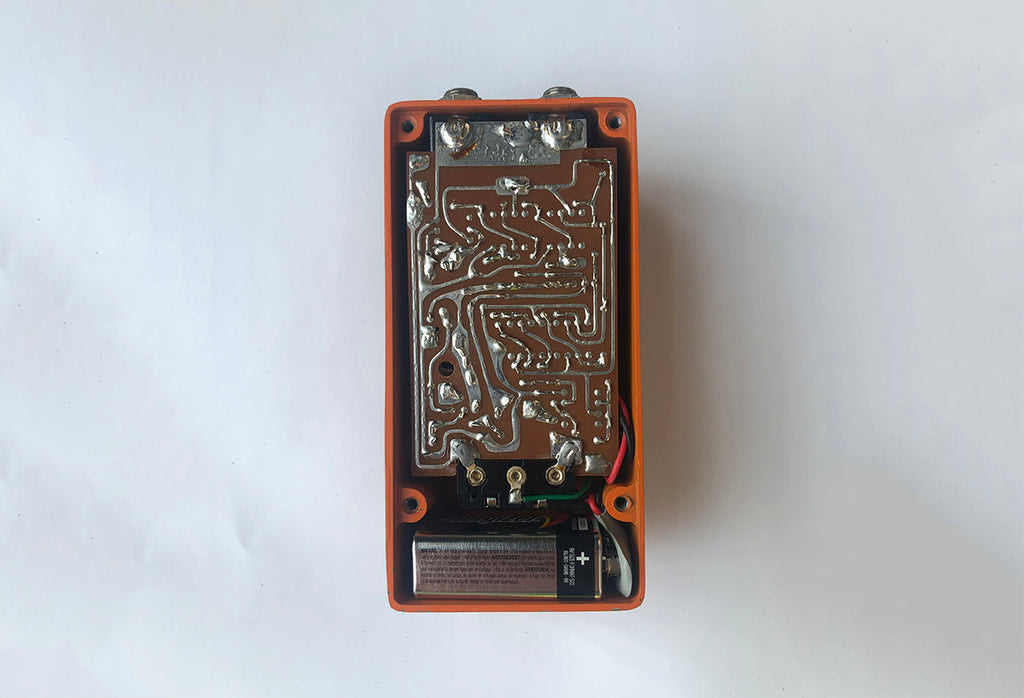Coron Phaser 55

After several of these Cabinet vignettes, it’s safe to say that we are showing no signs of slowing. In fact, the sheer volume sometimes gets me feeling nostalgic. Have you ever looked around your own collection and asked, “how did we get here?” The answer lies within this pedal, the Coron Phaser 55.
Well, not this pedal in particular, but the idea behind it contributed to the cramming of shelves with products and ensuring that jamming econo was a path one could actually take all the way to the top. In short, the Phaser 55 and its ilk all but ensured you could easily jam on a budget, and that generations of players could try out new genres and tones at a moment’s notice and on a pauper’s pay.
The period in question is the so-called “lawsuit era,” circa ‘77–’88, and it was fueled by a slice of Japan’s technology sector with a rugged determinism to enter the musical instrument market at a lower price point than its immediate competitors. The targets of infiltration were Boss, Korg and Ibanez (also Maxon, but that’s a separate story). As you may note, two of those are modern effects stalwarts, but in the height of the aforementioned era, all three were vying for a share of the growing market. All three are around today, of course, but it wasn’t without stiff competition from then-unknown companies pulling strings in the shadows.
Though the practice of cranking out guitars with coincidental body types is commonplace here and now, the nickname of the nondescript era that’s normally referred to as “lawsuit” actually pertains to a particular case. In 1977, Gibson sued Ibanez for aping its telltale book-style headstock. It was settled out of court for an unnamed sum, and the proverbial book was closed.
The nickname stuck around however, applied to lower-cost instruments bearing a slight resemblance to those found Stateside. And while that gentle mimicry was happening in the stringed instrument world, the real knock-offs were found under the feet of guitarists rather than in their hands.
Our story starts at a Japanese factory in Matsumoto, in Nagano Prefecture. Though home to several guitar-adjacent companies such as Gotoh and FujiGen Gakki, Matsumoku is a smaller factory that supplied many different companies with guitar product. A staggering amount of brands were given life (and subsequent distribution) in this factory and through its efforts—with some resembling American contemporaries.

Just a three hour drive from Matsumoto in the city of Urawa, another factory was hard at work chipping away at works from manufacturers all over the globe. Not one musical entity was immune to the machines on the cutting room floor, as circuits were dissected, reanimated and repackaged under dozens of different brand names, and in dozens of different enclosure types. The roster included notable names such as Guyatone, Yamaha and Locobox, as well as several other new names, such as DigiPlay, Memphis, Cutec and yes, Coron.
Oftentimes, the original circuits came straight from one manufacturer: MXR Innovations of Rochester, New York. Almost all others came from Boss and a select few from Electro-Harmonix. As for MXR, this was not the company’s first foray into the clone world, having had its circuits combed over by Ross Electronics of Chanute Kansas. The Coron Phaser 55 is one such pedal that was more than a little inspired by its MXR counterpart. However, the Coron is a rare occurrence when a company improved on the base circuit.
While MXR’s phaser line is iconic in every way, some of the Coron circuits included a “Feed Back” control, which piped the output signal back into the input for a juicier sound. Though MXR produced three different phaser models, it never included a feedback control of any kind. Until the Coron Phaser 55 arrived on the scene, the Boss PH-1r was the only compact phaser with such a control. Bruce Kulick of Grand Funk Railroad and Kiss knows what’s up; he’s used a Coron Phaser 50 (the non-”Feed Back” model) in at least one of his setups.
Prior to this effects boom, Japan heavily invested in electronic components and the results paid dividends. Urawa was pumping out pedals at a record pace. The sheer volume of these pedals flooded American markets and found ways into every store imaginable. Small musical instrument shops couldn’t afford not to carry them, and they were subsequently consumed and resold to these very same shops, effectively halving the value. Some years later, these pedals—with circuits nearly identical to the big boys—were voraciously acquired by budget-limited players. This influx of cheap and awesome-sounding product stoked interest in pedals in ways none of the bigger companies could have dreamed of. And as pedals further became fashionable, collectors swooped in and snatched up the remains. While these companies eventually dissolved into the ether, interest in pedals did not.
Though it’s hard to name any of the companies outside of the ones listed in this piece, there is no doubt that these humble effects ignited the boutique boom and led us to where we are today, as insatiable nerds that love every minute of this.
